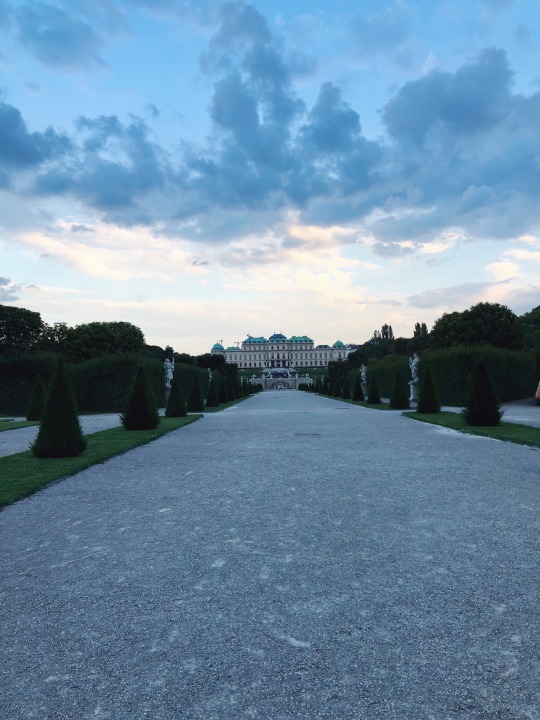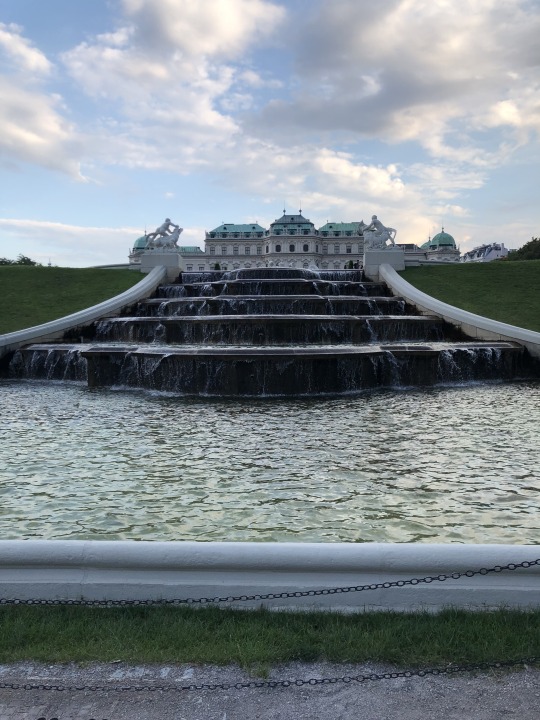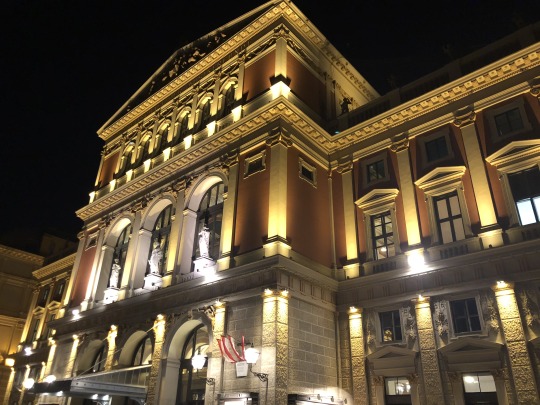Text
Self-Assessment
As I embarked on this musical journey to Vienna, Austria, I thought to myself: “What did I get myself into?” I mean literally…Going to a place I have never been, with people I have never met, and a language I have never spoke… So many people thought I was crazy for wanting to do this all on my own, and quite frankly, I did too. Initially when I first heard about the Magellan Project I thought to myself: “I would never want to do that.” However, after going to W&J for two years, I wanted to try something new and open my eyes to the bigger and better things of this world, and so I did.
I chose to travel to Vienna since it is known as the “City of Music.” I chose to study music because it is something that I am very passionate about, but not able to dedicate as much time as I would like too. I play four instruments, (three of which I taught myself), and I also sing. I thoroughly enjoy listening to classical music, however, I don’t always get the opportunity to hear it being performed live. During my Magellan I had the chance to hear three live performances of three extremely talented operas and orchestras. I wanted to study how prevalent music is in the Viennese lifestyle. More specifically, classical music. During my three weeks in Vienna I saw operas, composers’ homes, live orchestras, and many street performers.
Not only did I learn more about myself and what my capabilities are, I learned about the Viennese lifestyle. As someone who is an avid music lover, I felt right at home. Every time you turn the corner in Vienna someone is playing an instrument, singing an opera, or just simply jamming out to their own tunes. The women were more likely to be seen carrying a musical instrument than a purse. The historical architecture really allows you to picture yourself walking along the same cobblestone streets that Beethoven and Mozart did. Not to mention, there is something Mozart related on every street in Vienna (as well as men dressed up in Mozart costumes).
The people of Vienna pride themselves in their musical capabilities and I understand why. It is the one thing that genuinely unites the city. Even an average orchestra is far better than anything I have ever heard in the United States before. When I was walking in front of the famous Opera House in Vienna, one man dressed up in a Mozart costume stopped me and said: “You know what I have noticed about people who enjoy classical music?” I said, “What is that?” He said: “They carry themselves with much higher confidence than the average person does.” It took me a second to really understand what he was saying… However, as I thought about it for a little while, I believe he was right. They carry themselves with this confidence because they have a special talent. These people have been playing their instrument for as long as they can remember. They put in endless hours of practice each day, and those who perform professionally practice even more. When listening to talented musicians like the ones in Vienna, I get chills. How can it be humanly possible to not miss a single note, stay on rhythm perfectly, and memorize such hard sheet music? This musical lifestyle is such a prevalent part of their culture. Even the street performers have a unique talent that they love to share with the city. It is truly astounding watching everyone gather around to listen to some live music.
There are on average 10-15 musical performances a day in Vienna. So essentially, there are at least 70 performances a week that people are encouraged to go see. This doesn’t even include the hundreds of street performers, who are sometimes even better than a professional orchestra. It is interesting to watch the people of Vienna and how they spend their evenings. Instead of going to happy hour on a Thursday, or brunch on a Sunday, they find a local performance to watch. Everyone gets dressed up and grabs the closest seat to the stage that they can get. This is their ideal evening.
Historically, Mozart, Beethoven, Schubert, Brahms, and Strauss all have museums in Vienna. Mozart and Strauss, though, have left the biggest legacy in the city. There are many Mozart shops all over the central part of the city. During many performances the musicians were dressed as Mozart to put you “back in Mozart’s time.” His music was so beautiful and moving—when the orchestras performed his pieces they made sure they didn’t miss a beat. He is a musical icon in Vienna. Strauss is considered to be the “Waltz King” for his well-known melody: On the Beautiful Blue Danube. Every performance I went too they played this song at the end. The audience looked forward to it every time.
Going into this trip, I never realized how much I would grow from the Magellan Project. Adapting to an entirely new culture is not easy and can be frustrating at times—but every little bump in the road is a part of the experience. It appears that you learn more about yourself when you are pushed outside of your comfort zone, and this is exactly what the Magellan Project does. It forces you to extents I would have never thought of reaching at 19 years old. After traveling on my own for three weeks, I really feel like I can conquer anything this world throws at me. During my experience I have learned many things. I have learned that the beauty of this world is infinite. I have learned that there is so much more to this life than what you are used too. I have learned that the musical talent in Vienna is truly astounding. I have learned that the only limits in this world are the ones that you create for yourself. And lastly, I have learned that you can truly do anything you set your mind too, as long as you have the courage to pursue it. I will be forever grateful with this opportunity of a lifetime that I was granted at W&J and will encourage many others to reach outside of their box, as well. This world is a very beautiful place, and through my Magellan project I was able to discover even more of it.
- Katelyn
3 notes
·
View notes
Text
Johann Strauss Apartment
This very lavish apartment in Vienna was home to the “Waltz King,” Johann Strauss.
Inside of these beautiful walls Strauss composed perhaps one of the greatest Waltz’s of all time; On the Beautiful Blue Danube.
He lived in this apartment from 1863-1870. The Strauss family left a legacy in Vienna, and most of their music is still performed at concerts today. Every concert that I have went too they performed pieces from Strauss.

“The Blue Danube Waltz”

Violin display case that Strauss used

Strauss’s home organ!

Strauss’s standing desk-- it said that he always wrote his music while standing.

The Strauss family.







Strauss’s cabinet for his sheet music.
I am very sad as this was my last musical site for my trip. I hope you have enjoyed following this musical journey.
Look forward to one more post that is required for me, called the “Self-Assessment.” I will be sharing what I have learned from this Magellan Project,
- Katelyn
3 notes
·
View notes
Text
The Belvedere
This is another place you must see when in Vienna! Not musically related, but absolutely beautiful.
There are so many incredible palaces in Vienna, and here is another one.






- Katelyn
4 notes
·
View notes
Text
Ressel Park
Lots of musical history is shown in this park. They say that Brahms walked these same roads almost everyday to get to his apartment.

The Church above is Vienna’s largest Baroque church.
Three different musical weddings took place here.
1. Johann Strauss’s second wedding
2. Gustav Mahler’s wedding
3. Mahler’s sister married Arnold Rosé, a violinist who was very popular at the time. He lead the Vienna Philharmonic Orchestra for over fifty years.
It is also said that on November 2, 1762, Mozart went and visited this church with Leopold Mozart (his father).

- Katelyn
5 notes
·
View notes
Text
July 25th
Today I went all over Vienna. However, the main place that I went to was Stadtpark.
This park really values Vienna’s musical history. It had five statues of great composers.
The main statue, and perhaps the most famous one of them all, is the golden statue of Johann Strauss Jr. Many people were surrounding the statue taking pictures.
The Strauss family really left a legacy in Vienna. Johann Strauss is known as the “Waltz King” here in Austria.
The statue was created in 1921. It shows Strauss playing the violin while being surrounded by romantic figures.

- Katelyn
3 notes
·
View notes
Video
tumblr
The inside of the Musikverein! So beautiful.
4 notes
·
View notes
Text
July 21st
Today I went to the Haydnhaus! This also featured a room dedicated to Brahms, another very famous composer here in Vienna.
Haydn lived here for the last 12 years of his life.
While he lived here, he composed two very famous pieces: The Creation and The Seasons.
The museum opened in 2009 to commemorate the 200th anniversary of Haydn’s death. He died here in 1809, at age 77.
This museum also featured a room for Johannes Brahms, which is the only one in Vienna. It contained his original furniture, a portrait, and other memorabilia.


Haydn wrote this song in 1801 about his apartment!

Haydn’s clavichord



Johannes Brahms in 1896.
Brahms greatly admired Haydn.
Brahms music represents an important connection between Viennese Classicism and Viennese Modernism.
He owned 6 scores of Haydn’s String Quartets, and also the clavichord pictured above.
- Katelyn
5 notes
·
View notes
Text
Budapest
With a 2.5 hour train ride, I found myself traveling to Budapest to explore some more!
Budapest is a city split into Buda and Pest by the Danube river.
Johann Strauss the II actually made a very popular piece titled “The Blue Danube.”
Each concert that I have gone too so far has performed this song. (Even the Mozart concerts because this song is so well-known).
Just like Vienna, Budapest was filled with many street performers, and people advertising many orchestras and operas. It is evident that Vienna is the “City of Music,” however there was still a lot of musical influence here. Much more than the United States.
- Katelyn
3 notes
·
View notes
Text
July 20th
Today I saw the Vienna Mozart Orchestra at the Musikverein!
This music hall is one of the most famous in the world. The acoustics and beauty were impeccable.
Not only did Brahms’s Second and Third symphonies premiere here, but many others did as well.
The official name of this building is the “Building of the Society for the Friends of Music,” but in Vienna, it is known as the Musikverein. Annually, this concert hall sees around 600,000 visitors.
Many of Mozart’s famous pieces were performed tonight. The orchestra was breathtaking; during many songs I got chills. The opera singers were very active with the crowd and kept everyone engaged.
It all seemed so natural for them-- they just perform extremely difficult pieces so easily. The main violinist could play multiple pieces without even looking at her sheet music. It is shocking to me how Vienna keeps this extremely old classical music alive. This city is clearly made up upon music; and it is one thing that unites them all.
One of the people working at this hall said to me today: “You know what I’ve realized about people who enjoy classical music? They carry themselves with much higher confidence than people who don’t.” Walking away from hearing that I thought to myself... is that true? I believe it is. Classical music has a way of moving you intellectually in ways that other types of music cannot. It is not easy to play this music at such caliber, but the people of Vienna do it well, and in this sense, they carry themselves with confidence...As they should.
I am so grateful to have this opportunity through W&J’s Magellan Project. I have grown not only intellectually, but emotionally as well, and I am only halfway through.
All of the people who performed tonight clearly gave 110%. I wish I could watch these people perform again.




Take care,
- Katelyn
3 notes
·
View notes
Text
Mozart’s Statue
It’s obvious that Mozart has left a legacy in Vienna’s musical history.
Many great composers came from here, but Mozart can literally be seen, or heard, from every corner in Vienna.
They even sell “Mozart Balls” at almost every tourist attraction. They’re balls of chocolate with Mozart tin foil wrapped around it. They were pretty good.
Every orchestra, opera, street performer, etc, is usually performing at least one piece from Mozart.
His statue was quite beautiful, and really captured how much the citizens of Vienna admire him.


- Katelyn
4 notes
·
View notes
Photo

Every time the sun sets the clouds turn into cotton candy ☁️
3 notes
·
View notes
Video
tumblr
Views from the very top overlook the whole city ✨
3 notes
·
View notes
Video
tumblr
The room that you walk through before getting onto the Ferris Wheel!
3 notes
·
View notes
Text
The Prater
The Prater is a must-see for Vienna tourists, it has over 250 attractions and the famous Giant Ferris Wheel!
After visiting Beethoven’s home, I grabbed a quick bite to eat and headed over to the Prater. I needed to see what the hype was all about!
The Giant Ferris Wheel is iconic to the city of Vienna. It was built in 1897. It burned down during WWII but was quickly rebuilt in 1947.
Now the ride is used for tourist attractions, a symbol of history, proposals, or a romantic candlelight dinner.
You get a view that overlooks the whole city. It was so beautiful. (And a little scary).

The views from (almost) the top

They have their old carts in a room filled with different historical events that the wheel has been through, so you get a little historical information before you ride the Ferris Wheel.

The inside of one of the carts.
- Katelyn
4 notes
·
View notes